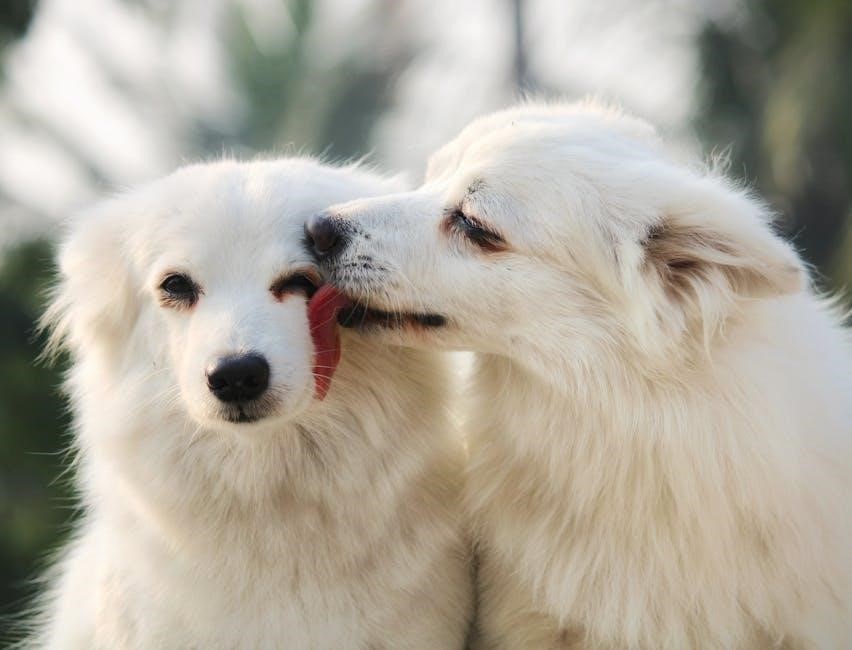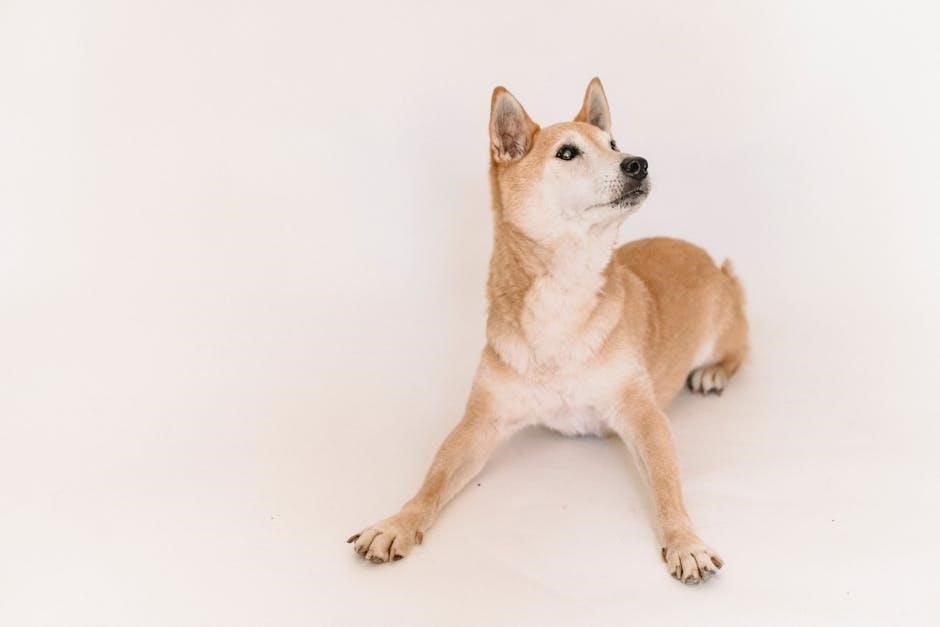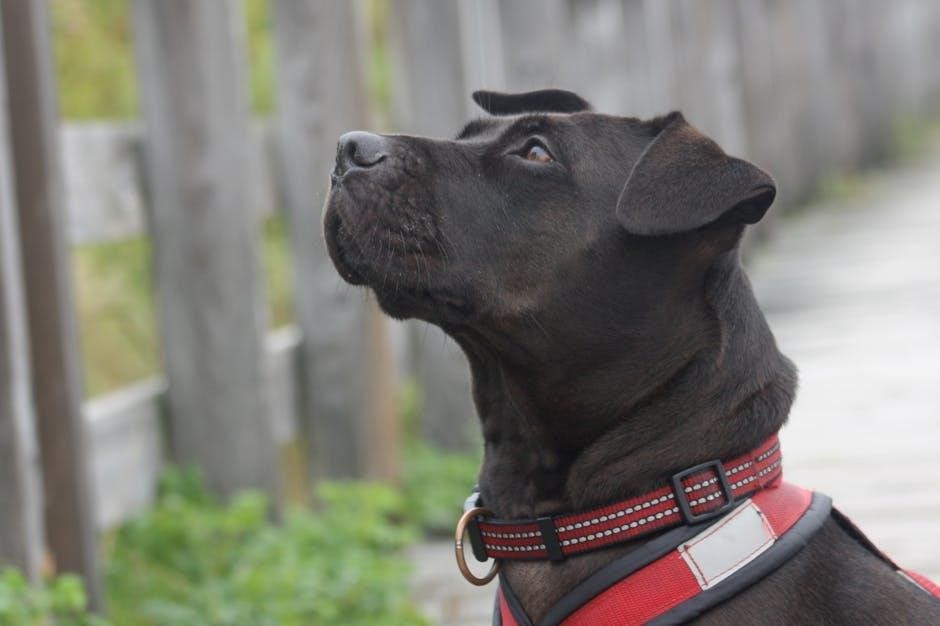baskerville muzzle size guide

The Baskerville Muzzle Size Guide helps dog owners choose the perfect fit for their pets, ensuring comfort, safety, and functionality. Proper sizing is crucial to prevent restricted breathing, discomfort, and behavioral issues, while allowing dogs to pant, drink, and eat treats. This guide provides detailed measurements and tips to select the ideal muzzle size, catering to various breeds and muzzle shapes. It emphasizes the importance of accurate measurements and adjustable features for a secure, humane fit, making training and outings stress-free for both dogs and owners.
Overview of Baskerville Muzzles
Baskerville muzzles are renowned for their durability and comfort, designed to suit various dog breeds and needs; Made from high-quality, flexible rubber, they offer a humane solution for training, socialization, and managing behaviors. Their ergonomic design allows dogs to pant and drink comfortably, ensuring a stress-free experience. Available in multiple sizes, Baskerville muzzles cater to small, medium, and large breeds, providing a secure fit without compromising comfort. Their adjustable straps and breathable material make them a popular choice for professionals and pet owners alike.
Importance of Proper Fit for Dog Muzzles
A proper fit is crucial for dog muzzles to ensure comfort, safety, and effectiveness. An ill-fitting muzzle can lead to discomfort, restricted breathing, or even safety risks. A well-fitted muzzle allows dogs to pant, drink, and move naturally, reducing stress and anxiety. Proper fit also prevents the muzzle from shifting or causing chafing, ensuring it serves its intended purpose without harming the dog. This guide helps owners choose the right size, guaranteeing a humane and functional solution for their pets.

Why Size Matters for Baskerville Muzzles
Proper sizing ensures comfort, safety, and functionality. Incorrect sizes can cause discomfort or reduce effectiveness, making accurate measurements crucial for a reliable fit.
Ensuring Comfort and Safety
A well-fitted Baskerville muzzle prevents discomfort, skin irritation, or restricted breathing. Proper sizing allows your dog to pant and drink naturally, ensuring their well-being during use. A muzzle that is too tight can cause distress, while one that is too loose may not serve its purpose effectively. Correct sizing ensures your dog remains calm and comfortable, making training and outings stress-free. Always prioritize a snug yet breathable fit to maintain your dog’s safety and happiness.
Preventing Restricted Breathing and Discomfort
A correctly sized Baskerville muzzle ensures unrestricted breathing, essential for your dog’s well-being. Proper fit prevents the muzzle from pressing too tightly on the nose or throat, which can cause respiratory distress. Accurate measurements help avoid a snugness that limits airflow. A muzzle that is too tight can lead to discomfort, panting difficulties, or even anxiety. Ensuring a breathable fit guarantees your dog’s comfort and safety while wearing the muzzle, making it a positive experience.
Impact of Incorrect Sizing on Dog Behavior
Incorrectly sized muzzles can significantly affect a dog’s behavior. A muzzle that is too tight may cause anxiety or aggression due to discomfort. Conversely, a loose muzzle can lead to limited control, potentially encouraging unwanted behaviors. Proper sizing ensures your dog remains calm and well-behaved, as it avoids unnecessary stress or frustration. A well-fitted muzzle promotes positive interactions and training experiences, making it essential for your dog’s emotional and behavioral well-being.

How to Measure Your Dog for a Baskerville Muzzle
To measure your dog for a Baskerville muzzle, use a soft tape measure. Measure the snout length, muzzle circumference, and width to ensure accurate sizing and comfort.
Measuring Snout Length
To measure your dog’s snout length, place a soft tape measure from the tip of their nose to the base, just below the eyes. Ensure the dog is calm and standing straight. The tape should be snug but not tight. Record the measurement accurately, as this determines the muzzle’s front-to-back fit. Proper snout length ensures the muzzle sits comfortably without digging into the skin, promoting both comfort and functionality for your dog.
- Start at the tip of the nose.
- End at the base, just below the eyes.
- Keep the tape measure level and snug.
This measurement is critical for ensuring the muzzle fits naturally and allows for proper breathing and movement.
Measuring Muzzle Circumference
To measure muzzle circumference, wrap a soft tape measure around the widest part of your dog’s snout, just below the eyes and nostrils. Ensure the tape is snug but not constricting. This measurement helps determine the muzzle’s overall size and comfort, ensuring it fits securely without restricting movement or breathing. Accurate circumference measurement is vital for a proper fit;
- Locate the widest part of the snout.
- Wrap the tape measure around it.
- Keep the tape snug and even.
This step ensures the muzzle aligns with your dog’s natural shape for optimal comfort and functionality.
Measuring Muzzle Width
To measure muzzle width, place a soft tape measure across your dog’s snout at its widest point, typically just below the eyes. Ensure the tape is level and not twisted. This measurement helps determine the muzzle’s size and ensures proper fit. A correct width allows the muzzle to stay securely in place without slipping or causing discomfort. Take multiple measurements to confirm accuracy for the best fit.
- Position the tape below the eyes.
- Ensure the tape is level and untwisted.
- Take several measurements for accuracy.
This ensures the muzzle aligns with your dog’s facial structure for comfort and functionality.

Baskerville Muzzle Size Chart
The Baskerville muzzle size chart provides a detailed guide, matching snout length and circumference measurements to specific sizes. It ensures accurate fit for various breeds and muzzle types.
Size Options and Corresponding Measurements
The Baskerville muzzle size chart offers a range of options to suit different dog breeds and sizes. Each size corresponds to specific measurements for snout length and circumference. For example, size 1 fits snouts measuring 6-7 inches in circumference and 3-4 inches in length, while larger sizes accommodate bigger breeds. The chart provides clear guidelines to help owners match their dog’s measurements to the most appropriate muzzle size, ensuring a comfortable and secure fit. Proper sizing is crucial for functionality and comfort.
Size Range for Small, Medium, and Large Breeds
Baskerville muzzles cater to dogs of all sizes, with options tailored for small, medium, and large breeds. Small breeds, like Pomeranians or Chihuahuas, typically fit sizes 1-2, while medium breeds, such as French Bulldogs or Beagles, suit sizes 3-4. Larger breeds, including Labradors or German Shepherds, require sizes 5-6. The size range ensures a comfortable fit, balancing safety and functionality for dogs of varying sizes and snout shapes. Proper sizing enhances comfort and effectiveness for training or behavioral needs.
Understanding the Size Chart for Accurate Fit
The Baskerville muzzle size chart provides detailed measurements to ensure a precise fit for your dog. It includes snout length, muzzle circumference, and width, which are essential for selecting the correct size. By matching your dog’s measurements to the chart, you can avoid sizing errors. Proper alignment with the chart ensures comfort, prevents restricted breathing, and allows for natural panting. Accurate fit is crucial for both functionality and your dog’s well-being during use.

Factors Influencing Muzzle Size Selection
Breed-specific considerations, snout shape, and adjustable features influence muzzle size selection. Proper fit ensures comfort, safety, functionality, and effectiveness for your dog.
Breed-Specific Considerations
Breed-specific considerations play a crucial role in selecting the right Baskerville muzzle size. Different breeds have distinct snout shapes and lengths, requiring tailored fits. For example, brachycephalic breeds like Pugs need roomier muzzles to accommodate their flat faces, while longer-nosed breeds such as Greyhounds may require more elongated sizes. Additionally, certain breeds may benefit from specific features like adjustable straps or heat-shaped customization to ensure comfort and proper fit. Consulting breed-specific sizing guidelines can help owners choose the most suitable muzzle for their dog’s unique anatomy.
Snout Shape and Muzzle Type
The shape and type of your dog’s snout significantly impact the fit of a Baskerville muzzle. Dogs with longer, narrower snouts may require a more contoured muzzle, while shorter, broader snouts need a wider design for comfort. Brachycephalic breeds, with flat faces, often need muzzles with extra space around the nose. Understanding your dog’s muzzle type ensures the Baskerville muzzle aligns properly, preventing discomfort or restricted breathing. A proper fit considers both snout length and shape for optimal comfort and functionality.
Adjustable Features for Custom Fit
Baskerville muzzles feature adjustable straps and a customizable thermal plastic nose piece, ensuring a tailored fit for your dog. The straps allow for precise adjustment around the snout and neck, while the heat-shaping technology enables you to mold the muzzle to your dog’s unique facial structure. These adjustable features prevent gaps or tightness, promoting comfort and safety. By customizing the fit, you can ensure your dog can pant, drink, and move naturally, making the muzzle both functional and comfortable for training or daily use.

Fitting the Baskerville Muzzle
Proper fitting ensures comfort and functionality. Start by adjusting the straps to secure the muzzle without restricting movement. Align the muzzle correctly to allow easy breathing and panting. Test the fit by observing your dog’s ability to drink and pant comfortably, ensuring no pressure points or restrictions. Regular checks and adjustments are essential for optimal comfort and safety.
Adjusting Straps for a Secure Fit
Adjust straps gently to ensure a snug but comfortable fit. Avoid overtightening, as this can cause discomfort or restrict breathing. Ensure the muzzle stays in place during movement.
Ensuring Proper Alignment and Comfort
Align the muzzle so it sits naturally on your dog’s snout. Check for any pressure points or rubbing. Ensure the muzzle allows for normal jaw movement and comfort.
Testing the Fit for Panting and Drinking
Observe your dog’s ability to pant and drink freely. A well-fitted muzzle should not obstruct these natural behaviors. Adjust as needed to ensure functionality and comfort.
- Start with a loose fit and gently tighten the straps to ensure the muzzle stays in place without restricting movement or breathing.
- Check each adjustment point to maintain even pressure and prevent hotspots that could cause discomfort.
- After tightening, observe your dog’s behavior to ensure the muzzle remains secure and comfortable during activities.
- Test the fit by allowing your dog to pant and drink freely, ensuring the muzzle doesn’t impede these essential functions.
Ensuring proper alignment and comfort is crucial for your dog’s well-being. The muzzle should sit securely, with the base straps resting just behind the ears and the muzzle itself aligned with the natural curve of your dog’s snout. Adjust the straps so the muzzle doesn’t shift during movement but remains snug enough to prevent slipping. Regularly check the fit to ensure your dog can pant and drink comfortably, as proper alignment prevents pressure points and discomfort. This ensures your dog remains calm and confident during walks or training sessions.
After fitting the muzzle, observe your dog’s ability to pant and drink water comfortably. A proper fit allows unrestricted breathing and slight mouth movement. Ensure the muzzle doesn’t press too tightly against the nose or cheeks, which could hinder breathing. Test by offering water to see if your dog can lap it up effortlessly. Adjust the straps if necessary to strike a balance between security and comfort, ensuring your dog can pant naturally and access water without obstruction.

Common Mistakes to Avoid When Sizing
When sizing a Baskerville muzzle, common mistakes include measuring with a closed mouth, which restricts panting, and ignoring snout shape variations across breeds.
- Measuring with a closed mouth limits accurate sizing for proper breathing and comfort;
- Overlooking adjustable straps can result in a poor fit, affecting both safety and functionality.
- Ignoring breed-specific snout shapes may lead to discomfort or restricted movement for your dog.
Measuring with Closed Mouth
Measuring your dog’s muzzle with a closed mouth is a common mistake leading to an improper fit. A closed mouth can cause the muzzle to be too tight, hindering panting and drinking. For accuracy, measure when your dog’s mouth is relaxed and slightly open. This ensures the Baskerville muzzle provides adequate space for breathing and comfort, crucial for your dog’s well-being and the proper function of the muzzle.
Ignoring Snout Shape and Breed Differences
One common mistake is not considering the unique snout shape and breed-specific features of your dog. Breeds like Bulldogs or Pugs have shorter, flatter snouts, while others, such as Dachshunds, have longer, narrower muzzles. Ignoring these differences can lead to an ill-fitting muzzle, causing discomfort or restricted breathing. Always consult the size chart and consider your dog’s anatomy to ensure a proper fit. Failure to do so may result in impaired breathing or skin irritation, undermining the muzzle’s effectiveness and your dog’s well-being.
Overlooking Adjustable Features
Overlooking adjustable features is a common mistake when selecting a Baskerville muzzle. Adjustable straps and panels ensure a customizable fit, preventing the muzzle from being too tight or too loose. Ignoring these features can lead to discomfort, restricted movement, or even ineffective use. Always utilize the adjustable components to tailor the muzzle to your dog’s unique shape and size for optimal comfort and functionality. This step is crucial for ensuring the muzzle serves its purpose effectively while keeping your dog at ease.

Materials and Design of Baskerville Muzzles
Baskerville muzzles feature heat-shaping technology for a custom fit, breathable and durable materials for comfort, and a padded interior for added comfort and stress reduction.
Heat-Shaping Technology for Custom Fit
Baskerville muzzles feature heat-shaping technology, allowing for a custom fit tailored to your dog’s unique snout shape. This innovative process involves thermoplastic materials that can be gently molded using heat to create a precise fit. The result is a muzzle that provides maximum comfort while ensuring safety and functionality. This technology addresses individual variations in snout shape and size, making it ideal for dogs with unique facial structures. Regular heat-shaping ensures a secure, non-restrictive fit for optimal comfort and performance.
Breathable and Durable Materials
Baskerville muzzles are crafted from breathable and durable materials to ensure comfort and longevity. The muzzle features a robust yet flexible thermoplastic rubber that withstands regular use while maintaining shape. The incorporated ventilation holes promote airflow, preventing overheating and keeping your dog cool. The materials are also resistant to chewing, making them ideal for strong-jawed breeds. This combination of durability and breathability ensures the muzzle remains functional and comfortable for your dog, even during extended wear.
Padded Interior for Added Comfort
The Baskerville muzzle features a padded interior designed to enhance comfort during use. This soft padding ensures that the muzzle does not cause irritation or chafing, making it ideal for extended wear. By cushioning the dog’s snout and facial area, the padded interior promotes a more pleasant experience, reducing stress and discomfort. This feature is particularly beneficial for dogs that require muzzling for training, grooming, or behavioral purposes, as it helps maintain their calm and cooperation.
Benefits of Properly Fitted Baskerville Muzzles
A properly fitted Baskerville muzzle ensures enhanced comfort, safety, and improved training outcomes. It prevents restricted breathing, discomfort, and skin irritation, allowing your dog to pant and drink naturally.
Enhanced Comfort and Safety
A properly fitted Baskerville muzzle ensures enhanced comfort and safety for your dog. The muzzle allows for natural panting and breathing, essential for your dog’s well-being. A snug, secure fit prevents unwanted nipping or eating while minimizing the risk of chafing or skin irritation. This design prioritizes your dog’s safety, reducing stress and anxiety during use. By ensuring proper alignment and comfort, the muzzle promotes a positive experience, making training and outings more enjoyable for both you and your dog.
Improved Training and Behavior
A properly fitted Baskerville muzzle can significantly enhance training and behavior by reducing stress and anxiety in dogs. When a muzzle is comfortable and well-sized, it allows dogs to focus on commands without the distraction of discomfort. This leads to better responsiveness during training sessions. Additionally, a secure fit minimizes anxiety-related behaviors like nipping or pulling, promoting a calmer demeanor. Over time, this can result in more effective training outcomes and a more positive experience for both the dog and handler.
Longevity and Durability of the Muzzle
A properly fitted Baskerville muzzle ensures longevity and durability by evenly distributing stress across the muzzle’s structure. High-quality, breathable materials resist wear and tear, while the heat-shaping technology maintains its shape over time. Regular cleaning and proper storage further extend the muzzle’s lifespan. A well-fitted muzzle also prevents excessive strain on adjustable straps, reducing the risk of premature damage. This combination of durable design and careful maintenance ensures the muzzle remains functional and comfortable for your dog over an extended period.

Troubleshooting Common Fit Issues
If your dog’s Baskerville muzzle feels too tight or loose, adjust the straps for a secure fit. Check for gaps or restricted breathing and ensure proper alignment.
- Address tightness by loosening straps slightly, ensuring comfort without compromising security.
- For gaps, tighten straps evenly, maintaining your dog’s ability to pant and drink.
Addressing Gaps or Tightness
When your dog’s Baskerville muzzle has gaps or feels too tight, it can compromise comfort and functionality. Start by checking the strap adjustments—loosen for gaps or tighten for snugness. Ensure proper alignment by repositioning the muzzle to fit naturally along your dog’s snout. If issues persist, consult the size chart to verify if a different size is needed. Regular fit checks are essential, especially as your dog grows or gains/loses weight. Adjust accordingly to maintain comfort and safety.
Resolving Restricted Panting or Breathing
If your dog experiences restricted panting or breathing, check the muzzle fit immediately. A muzzle that is too tight can impede airflow, leading to discomfort or distress. Loosen the straps slightly to ensure proper ventilation while maintaining a secure fit. Ensure the muzzle allows for open-mouth panting, as this is crucial for temperature regulation. Refer to the size chart to confirm correct sizing, and consider a larger size if necessary. If issues persist, consult a professional for guidance.
Adjusting for Optimal Comfort and Functionality
Proper adjustments are key to ensuring your dog’s Baskerville muzzle is both comfortable and functional. Start by loosening all straps and gently placing the muzzle on your dog. Tighten the adjustable straps evenly, ensuring the muzzle isn’t too tight or restrictive. Check that your dog can pant, drink, and move their jaw comfortably. If needed, make micro-adjustments to the straps for a balanced fit. Regularly inspect and adjust the muzzle as your dog grows or gains/loses weight to maintain optimal comfort and functionality.

Care and Maintenance of Baskerville Muzzles
Regular cleaning with mild soap and water prevents bacteria buildup. Store in a dry place to avoid mold. Avoid extreme heat to maintain shape retention.
- Clean with mild soap and water to prevent bacteria buildup.
- Store in a dry, well-ventilated area to avoid mold growth.
- Avoid exposing to extreme heat to maintain the muzzle’s shape.
Cleaning and Hygiene Practices
Regular cleaning of your Baskerville muzzle is essential for maintaining hygiene and your dog’s comfort. Use mild soap and warm water to wipe down the muzzle, paying attention to areas prone to drooling or moisture buildup. Avoid harsh chemicals, as they may damage the materials. Rinse thoroughly and allow the muzzle to air dry to prevent bacterial growth. For daily maintenance, a damp cloth can be used to wipe away surface dirt. Regular cleaning ensures a fresh, comfortable fit for your dog.
Storing the Muzzle Properly
To maintain the durability and shape of your Baskerville muzzle, proper storage is essential. After cleaning, allow the muzzle to air dry completely to prevent moisture buildup; Store it in a cool, dry place away from direct sunlight to avoid warping or cracking. Keep it out of reach of your dog to prevent accidental damage. For optimal preservation, place the muzzle in its original packaging or a protective case to shield it from dust and scratches. This ensures it remains in excellent condition for future use.
Maintaining Shape and Durability
To preserve the shape and durability of your Baskerville muzzle, store it flat or in its original packaging when not in use. Avoid exposing it to extreme temperatures, as this can warp the material. Regularly clean the muzzle with mild soap and water, then allow it to air dry. Avoid using harsh chemicals or abrasive cleaners, as they may damage the thermoplastic. Handle the muzzle gently to prevent bending or creasing, and inspect it periodically for signs of wear. Proper care ensures the muzzle remains effective and comfortable for your dog.
Choosing the right Baskerville muzzle size ensures comfort, safety, and effectiveness. Proper fit prevents discomfort and behavioral issues, while correct sizing promotes a positive experience for your dog.
Final Tips for Choosing the Right Size
When choosing the right size for your Baskerville muzzle, always prioritize your dog’s comfort and safety. Take precise measurements and consult the size chart to avoid guessing. Consider your dog’s breed, snout shape, and growth stage, especially for puppies. Try the muzzle on to ensure a snug yet comfortable fit, allowing for panting and drinking. Adjust straps carefully and monitor your dog’s behavior during fitting. Proper sizing ensures a positive experience and effective functionality.
Importance of Regular Fit Checks
Regular fit checks are crucial to ensure your dog’s Baskerville muzzle remains comfortable and functional over time. Dogs grow and change, so what fits today may not fit tomorrow. Factors like weight fluctuations or dental changes can alter the muzzle’s fit. Check for any gaps or tightness, as these can lead to discomfort or restricted breathing. Schedule regular inspections and make adjustments as needed to maintain your dog’s comfort and safety. This proactive approach ensures the muzzle continues to serve its purpose effectively.
Ensuring a Positive Experience for Your Dog
Introducing your dog to a Baskerville muzzle should be a positive experience to build trust and confidence. Start by letting your dog explore the muzzle at their own pace, using treats and praise to create a positive association. Gradually increase wear time, ensuring they remain calm and comfortable. Always monitor their behavior and adjust as needed to prevent anxiety or stress. A well-fitted muzzle, combined with patience and positive reinforcement, helps your dog feel secure and relaxed in their new accessory.
Regular fit checks and adjustments are crucial to maintain your dog’s comfort. Pay attention to their body language and reactions during use. If they show signs of distress, such as excessive panting or resistance, reassess the fit and sizing. By prioritizing your dog’s comfort and confidence, you can ensure the muzzle becomes a helpful tool rather than a source of discomfort. This approach fosters a positive relationship between your dog and their muzzle, making training and outings more enjoyable for both of you.



Leave a Reply
You must be logged in to post a comment.